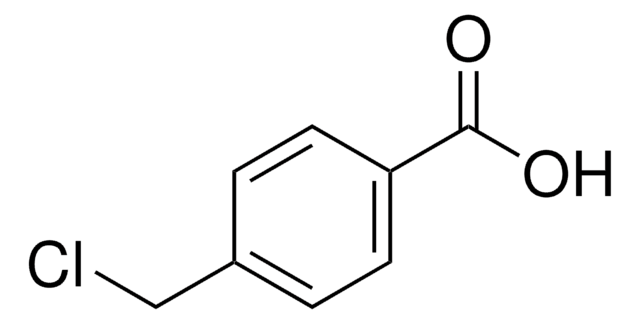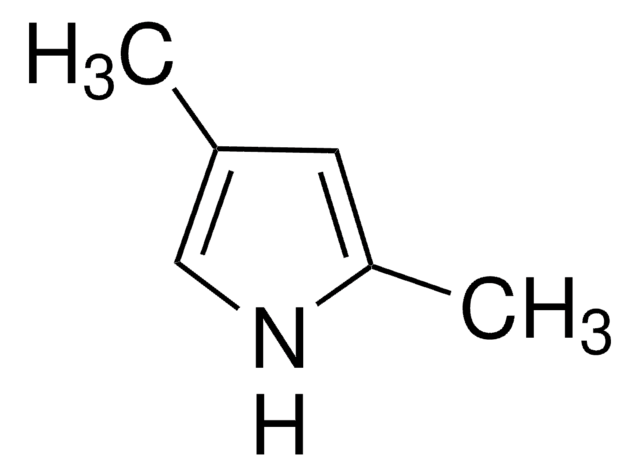Wszystkie zdjęcia(2)
Kluczowe dokumenty
270784
4-(Chloromethyl)benzoyl chloride
97%
Zaloguj sięWyświetlanie cen organizacyjnych i kontraktowych
About This Item
Wzór liniowy:
ClCH2C6H4COCl
Numer CAS:
Masa cząsteczkowa:
189.04
Numer WE:
Numer MDL:
Kod UNSPSC:
12352100
Identyfikator substancji w PubChem:
NACRES:
NA.22
Polecane produkty
Poziom jakości
Próba
97%
tw
126-128 °C/6 mmHg (lit.)
mp
30-32 °C (lit.)
grupa funkcyjna
acyl chloride
chloro
ciąg SMILES
ClCc1ccc(cc1)C(Cl)=O
InChI
1S/C8H6Cl2O/c9-5-6-1-3-7(4-2-6)8(10)11/h1-4H,5H2
Klucz InChI
RCOVTJVRTZGSBP-UHFFFAOYSA-N
Powiązane kategorie
Zastosowanie
4-(Chloromethyl)benzoyl chloride was used as an atom transfer radical polymerization (ATRP) initiator in the growth of polyacrylamide (PAAm) brushes from silicon wafers. It was also used as a building block in a microwave-assisted, solid-phase synthesis of imatinib, an anticancer agent.
Ta strona może zawierać tekst przetłumaczony maszynowo.
Hasło ostrzegawcze
Danger
Zwroty wskazujące rodzaj zagrożenia
Zwroty wskazujące środki ostrożności
Klasyfikacja zagrożeń
Eye Dam. 1 - Skin Corr. 1B - STOT SE 3
Organy docelowe
Respiratory system
Kod klasy składowania
8A - Combustible corrosive hazardous materials
Klasa zagrożenia wodnego (WGK)
WGK 3
Temperatura zapłonu (°F)
199.4 °F - closed cup
Temperatura zapłonu (°C)
93 °C - closed cup
Środki ochrony indywidualnej
Faceshields, Gloves, Goggles, type ABEK (EN14387) respirator filter
Wybierz jedną z najnowszych wersji:
Masz już ten produkt?
Dokumenty związane z niedawno zakupionymi produktami zostały zamieszczone w Bibliotece dokumentów.
Klienci oglądali również te produkty
Irina Cringus-Fundeanu et al.
Langmuir : the ACS journal of surfaces and colloids, 23(9), 5120-5126 (2007-03-29)
A method is presented to prevent microbial adhesion to solid surfaces exploiting the unique properties of polymer brushes. Polyacrylamide (PAAm) brushes were grown from silicon wafers by atom transfer radical polymerization (ATRP) using a three-step reaction procedure consisting of immobilization
Tetrahedron Letters, 48, 3455-3455 (2007)
Song Yi Lee et al.
ACS applied materials & interfaces, 10(43), 36628-36640 (2018-10-10)
CD44 receptor targeting and lipid rafts destroying nanoassembly (NA) was developed for breast cancer therapy. Methyl-β-cyclodextrin (MbCD), as a cholesterol depletion moiety, was conjugated to hyaluronic acid-ceramide (HACE) structure via an ester linkage. HACE-MbCD NA with 198 nm hydrodynamic size
Ali Bilgic et al.
Journal of fluorescence, 30(4), 867-881 (2020-06-05)
In this study, we developed two different very sensitive magnetite fluorescent Fe3O4@SiO2-TPED-BODIPY and Fe3O4@SiO2-TMPTA-BODIPY nano-sensors for the selective detection of Cr(VI) ions. The Cr(VI) metal ions sensing is based on the fluorescent quenching of BODIPY functionalized with Fe3O4@SiO2-TPED and Fe3O4@SiO2-TMPTA
Andrej Babič et al.
Chemistry (Weinheim an der Bergstrasse, Germany), 24(6), 1348-1357 (2017-11-10)
Gadolinium-loaded nanomicelles show promise as future magnetic resonance imaging (MRI) contrast agents (CAs). Their increased size and high gadolinium (Gd) loading gives them an edge in proton relaxivity over smaller molecular Gd-complexes. Their size and stealth properties are fundamental for
Nasz zespół naukowców ma doświadczenie we wszystkich obszarach badań, w tym w naukach przyrodniczych, materiałoznawstwie, syntezie chemicznej, chromatografii, analityce i wielu innych dziedzinach.
Skontaktuj się z zespołem ds. pomocy technicznej


